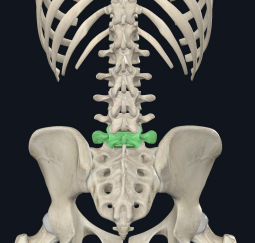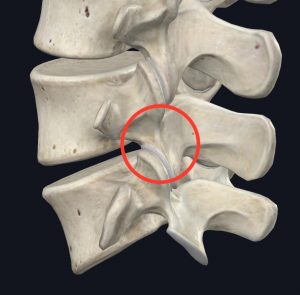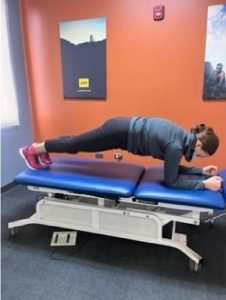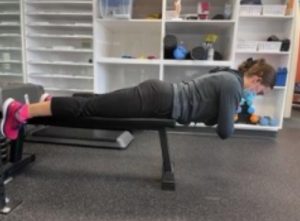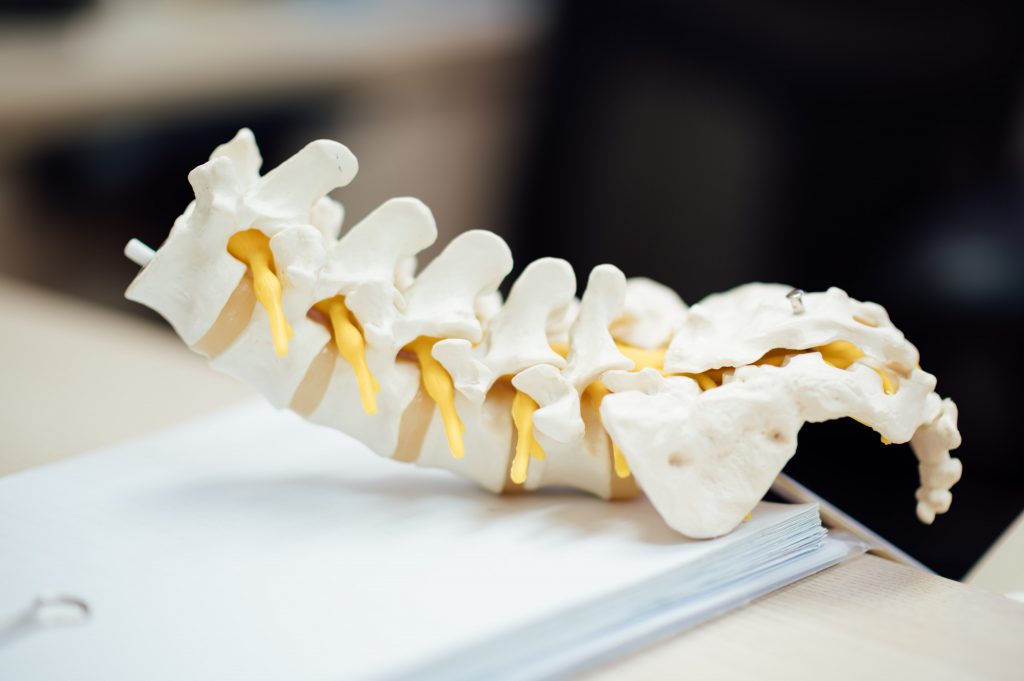
Have you ever woken up in the morning with back pain or stiffness?
Have you ever had to sit down after standing or walking for extended periods due to back pain or numbness and tingling down your legs?
These are common signs and symptoms that can be associated with arthritis or stenosis of the lumbar spine and/or lumbar radiculopathy commonly referred to as “sciatica”.
If you have been diagnosed with arthritis, stenosis, or lumbar radiculopathy, see our blogs on disc herniations or spinal stenosis for more information.
In rare occasions, back pain, stiffness, numbness and tingling down the legs, or weakness in the legs can be associated with spondylolisthesis.
Let’s take a closer look at spondylolisthesis and how physical therapy can help treat it!
What is Spondylolisthesis?
Spondylolisthesis comes from the Greek word spondylos meaning “spine” and listhesis meaning “slipping” and refers to the displacement of a spinal segment or vertebra from its original position.
Typically spondylolisthesis involves the lowest vertebra in the lumbar spine, L5 on S1, and less frequently at L4 on L5.
- The L5 vertebra | Image courtesy of Complete Anatomy
Spondylolisthesis can occur in both teens and adults. In fact, 4-6% of adults older than 50 years old, women more so than men, can have spondylolisthesis and not even know it! (1)
With repetitive backward bending in sports such as gymnastics or football, forward bending in sports such as lifting or cycling, or with faulty movement patterns over time as we age, a crack or fracture can occur in the pars interarticularis, the part between facet joints which link each vertebra, due to this repetitive stress.
- Pars interarticularis | Image courtesy of Complete Anatomy
This area of the spine prevents the movement of one vertebral segment on top of the other, and when it cracks, can no longer prevent excessive movement forward or backward of the spine allowing the vertebrae to move or slip.
The good news is if this slippage is what is considered low-grade (I or II), as in most cases of spondylolisthesis involving sport and degenerative cases, non-surgical treatment such as physical therapy can resolve nearly all of your symptoms!
High-grade slippage (III-IV) may require surgery, but the presence of a high-grade slippage should be confirmed by your doctor with an x-ray or MRI.
When To Seek Emergency Treatment
As spondylolisthesis can pinch or impinge upon the nerve roots that exit the lumbar spine, similar to a herniated disc. Due to the nature of this injury, there are times when it is appropriate and necessary to seek emergency medical treatment.
If you have any of the following signs or symptoms associated with low back pain or spondylolisthesis, please follow-up with your closet emergency medical provider:
- Acute, meaning new or recent onset, of bowel or bladder dysfunction including difficulty urinating or leakage.
- Acute, meaning new or recent onset, of severe fatigue.
- Night pain that is constant and does not change with position.
- Weight loss or gain > 10% of body weight within the last month.
- Progressive weakness or numbness/tingling of the legs that is worsening.
If you do not have any of the above signs or symptoms, it is then safe to directly seek physical therapy care.
Reach out to JACO Rehab at (808) 381-8947 if you or someone you know is looking for services for low back pain or spondylolisthesis.
Conservative Treatment for Spondylolisthesis
Initial treatment depends on your doctor and severity of symptoms.
Some doctors may recommend an epidural injection to initially manage your pain and swelling if your symptoms are severe. After an epidural injection, your doctor may recommend heat or ice application and medications (such as gabapentin and NSAIDs) to manage your pain and swelling.
If you have any questions regarding epidural injections, you can ask your doctor.
Physical therapy treatment for spondylolisthesis can vary based on your signs and symptoms, including how long symptoms have persisted and how severe they are with activity.
In cases where pain levels are high, movement is very limited, and numbness and/or tingling is present, the initial goal of physical therapy is to manage your symptoms by centralizing nerve pain and discomfort.
Physical therapy can also vary based on your specific method of injury and direction of the vertebral slippage known as anterolisthesis (slipping forward) or retrolisthesis (slipping backward).
Anterolisthesis versus Retrolisthesis
With most backward bending or extension based injuries, the vertebra slips forward. This is known as anterolisthesis.
In this case, repetitive extension of the spine like we see in gymnastics is strongly discouraged.
This is not to say that you have to avoid bending backward forever. A reasonable timeframe is 6-8 weeks to allow for tissue healing and reduction in swelling. However, until you are able to actively control the muscles around the spine to help stabilize the injured area, it is better to avoid these activities if they cause further pain.
With most forward bending or flexion based injuries, the vertebra slips backward. This is known as retrolisthesis.
In this case, repetitive flexion of the spine as in bending down to put on your shoes/socks is temporarily discouraged. Again, this is not to say that you have to avoid bending forward forever! We need those tissues to heal and muscles to strengthen to protect the injured area.
This is where physical therapy comes in handy.
Physical Therapy for Spondylolisthesis
The goal of physical therapy is to empower you with the tools to heal. Physical therapists evaluate your symptoms and work with you to develop a rehabilitation plan. It’s important that you stay consistent each week – movement and strength take a while to regain, so patience is key.
The first step is to regain pain-free range of motion at the spine and hips.
Your physical therapist will work with you on improving the length of your muscles which may be guarded and tightening around the area of injury. This also involves improving the mobility of the joints above and below the injured area to make general movement a little easier.
Regaining mobility is done through a variety of soft tissue techniques, including:
- soft tissue mobilization
- self-soft tissue release
- myofascial release
- manual stretching
- joint mobilizations
These techniques are complimented by your efforts. You’ll learn stretching and strengthening exercises specific to your needs that reinforce your new mobility.
Once you have regained full range of motion at the spine and hips, you can begin to work on stabilization exercises for the core, glutes, and even pelvic floor and diaphragm to help you learn to properly brace your spine.
Once you are feeling comfortable and confident, your therapist will then gradually add more strengthening activities. The goal is to get you back to your prior level of activity or sport.
Remember that patience is key here. Your strengthening activities gradually progress to decrease the risk of re-injury. As the old saying goes, you need to learn how to walk before you can run!
Core Strengthening: How to Get Started
Regardless of which type of spondylolisthesis you have, being able to brace your spine properly is key to offloading the area of injury.
One of the most common exercises for this is the plank!
Planking
The goal is to hold a proper plank for one to two minutes, but start with 10-30 second intervals. Practice three rounds.
- Start by properly tightening your lower abdominal muscles. Think about breathing into your belly in 360 degrees filling it up like a balloon. Then pull your belly button to your spine while exhaling.
- You should feel like you have a belt/corset wrapped around you.
- Make sure your elbows are placed directly under your shoulders and push the ground away, engaging the shoulder muscles.
- If you have tension in your neck, direct force toward your trunk instead by “pulling” your elbows under you without actually moving them.
- Straighten your knees and squeeze your bum to make sure your legs feel locked into place.
- Feet should be spread shoulder width apart or a comfortable distance.
If a floor plank is too challenging or you feel pain in your lower back, you can modify the exercise by going down to your knees. Or, perform it on an elevated surface like a bench or your kitchen counter.
Back Extension Isometric Hold
The core muscles also include the spinal extensors, not just the abdominals, so learning to properly recruit and utilize these muscles is key to treating and managing low back pain.
The goal is to hold this position for one to two minutes, but start with 10-30 second intervals. Practice three rounds.
- First find a bench or a physioball and place the edge of the bench or ball right at the top of your hips.
- Lift you trunk up to a neutral position – do not bend backwards. You should feel your back muscles engage, but no pain.
- Hold the position – try not to extend or sag out of a neutral position.
If this is difficult, you can adjust the position of the bench or physioball higher than your hips to make it easier until you’re ready for more challenge.
Reach Out!
At JACO, the physical therapy process is always tailored to you. Every single patient is unique, so we spend over 50 minutes during one-on-one sessions to make sure you’re getting the individualized treatment you need.
Reach out to us today and get back to living your life!
Written by Jennifer Lewis, DPT
References
1. Cleveland Clinic. Spondylolisthesis. Found online at https://my.clevelandclinic.org/health/diseases/10302-spondylolisthesis
